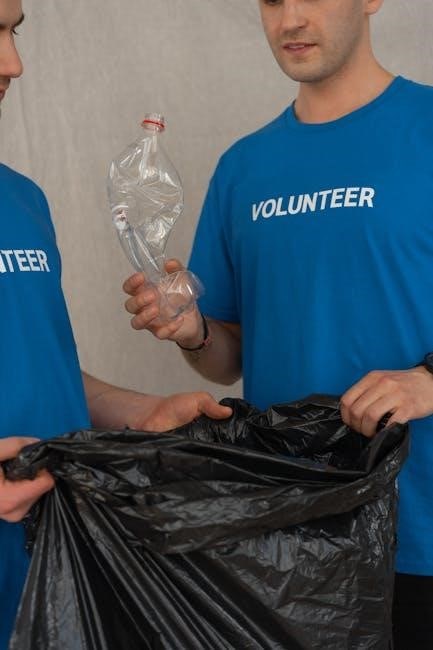dirty dozen and clean 15 pdf
The Dirty Dozen and Clean 15 lists, published annually by the Environmental Working Group (EWG), guide consumers on pesticide contamination in produce, helping them make informed choices for healthier, more sustainable diets.
Overview of the Dirty Dozen and Clean 15 Lists
The Dirty Dozen and Clean 15 lists rank fruits and vegetables based on pesticide contamination levels. The Dirty Dozen highlights produce with the highest residues, while the Clean 15 lists those with the lowest. Published annually by the Environmental Working Group (EWG), these rankings help consumers make informed choices to reduce pesticide exposure. The lists are based on extensive testing and analysis of pesticide levels in nonorganic produce. By understanding these rankings, shoppers can prioritize organic options for highly contaminated items and opt for conventional choices when contamination is minimal, promoting healthier and more sustainable diets.
Importance of Understanding Pesticide Contamination in Produce
Understanding pesticide contamination in produce is crucial for reducing exposure to harmful chemicals. The Dirty Dozen and Clean 15 lists provide insights into which fruits and vegetables are most and least contaminated. This knowledge helps consumers make informed decisions to minimize pesticide intake, particularly for vulnerable populations like children and pregnant individuals. By prioritizing organic options for highly contaminated items, shoppers can reduce health risks while supporting sustainable farming practices that promote environmental and human well-being.

The Dirty Dozen: Fruits and Vegetables with High Pesticide Contamination
The Dirty Dozen highlights produce with the highest pesticide residues, as identified by the EWG. Spinach tops the 2025 list, followed by strawberries and grapes, urging consumers to opt for organic options.
Top Contaminated Produce in the 2025 Dirty Dozen List
In 2025, spinach leads the Dirty Dozen list as the most contaminated produce, followed by strawberries, grapes, and pears. New entries like blackberries and sweet corn also rank high due to pesticide residues. The EWG’s analysis considers both pesticide concentration and toxicity, emphasizing the importance of choosing organic options for these items to minimize exposure. This list serves as a critical guide for consumers aiming to reduce their intake of harmful chemicals through informed grocery choices.
Spinach: The Most Contaminated Fruit or Vegetable in 2025
Spinach tops the 2025 Dirty Dozen list as the most contaminated produce, with alarming levels of pesticide residues. Testing revealed multiple pesticides on spinach samples, raising significant health concerns. The Environmental Working Group (EWG) highlights that consuming non-organic spinach regularly could expose individuals to a cocktail of harmful chemicals. This makes it crucial for consumers to opt for organic spinach to minimize pesticide intake. The findings underscore the importance of awareness and informed choices to reduce exposure to toxic substances in daily diets.
Other Notable Entries in the Dirty Dozen List
Beyond spinach, other produce on the 2025 Dirty Dozen list includes strawberries, blackberries, and sweet corn, with concerning pesticide levels. Blackberries and sweet corn are newcomers, highlighting growing contamination trends. Pears and grapes also rank high, with residues detected in nearly all samples. The EWG emphasizes that these findings underscore the importance of choosing organic options for these items to reduce pesticide exposure. Consumers are urged to prioritize organic purchases for these contaminated fruits and vegetables to safeguard their health and minimize environmental impact.
The Clean 15: Fruits and Vegetables with Low Pesticide Contamination
The Clean 15 list highlights produce with minimal pesticide residues, offering consumers a guide to safer, non-organic options. Avocados top the list as the cleanest fruit in 2025.
Top Clean Produce in the 2025 Clean 15 List
The 2025 Clean 15 list identifies produce with the lowest pesticide residues, offering consumers safer non-organic options. Avocados lead as the cleanest fruit, with minimal contamination. Sweet corn, pineapple, and frozen sweet peas also rank high, showing negligible pesticide traces. These fruits and vegetables are ideal for those seeking to reduce pesticide exposure without necessarily buying organic. The list is compiled by the EWG, ensuring transparency and helping shoppers make informed decisions for a healthier diet.
Avocados: The Cleanest Fruit in 2025
Avocados topped the 2025 Clean 15 list as the cleanest fruit, with minimal pesticide exposure. The EWG’s testing revealed that fewer than 2% of avocado samples contained detectable pesticide residues, making them a safe non-organic choice. Their thick skin protects the edible flesh from contamination, ensuring a healthy and nutritious option for consumers. This makes avocados an excellent addition to a balanced diet, offering both versatility and peace of mind for those prioritizing reduced pesticide intake without opting for organic produce.
Other Notable Entries in the Clean 15 List
Beyond avocados, the 2025 Clean 15 list highlights other produce with minimal pesticide residues. Sweet corn and pineapple are standout entries, with over 90% of samples showing no detectable pesticides. Kiwi and cabbage also rank highly, offering consumers affordable, non-organic options with low contamination risks. These fruits and vegetables are not only nutritious but also provide peace of mind for those seeking to minimize pesticide exposure without solely relying on organic choices.
Methodology Behind the Dirty Dozen and Clean 15 Rankings
EWG annually tests thousands of fruit and vegetable samples, analyzing pesticide residues and toxicity. Rankings are based on contamination levels, helping consumers prioritize organic choices effectively.
How the Environmental Working Group (EWG) Conducts Its Research
The EWG annually tests thousands of fruit and vegetable samples for pesticide residues, focusing on concentration and toxicity. Data is collected from USDA and FDA reports, ensuring accuracy. Samples are analyzed for over 200 pesticides, and results are ranked to determine contamination levels. The EWG considers both the amount of pesticides and their potential harm to human health. This rigorous process helps consumers identify which produce items are safest to buy conventionally and which should be purchased organic to minimize exposure.
Factors Considered in Pesticide Contamination Analysis
The EWG’s analysis considers pesticide concentration, toxicity, and the number of different pesticides found on produce. They also evaluate the percentage of samples contaminated and the effectiveness of washing or peeling in reducing residues. This comprehensive approach ensures the rankings reflect both the level and potential harm of pesticide exposure, helping consumers prioritize which fruits and vegetables to buy organic to minimize health risks.
Trends in Pesticide Use and Contamination
Recent trends show increasing pesticide toxicity in produce, with newcomers like blackberries and sweet corn joining the Dirty Dozen list, highlighting the growing need for organic choices.

Changes in the Dirty Dozen and Clean 15 Lists Over the Years
Over the years, the Dirty Dozen and Clean 15 lists have seen notable changes, reflecting shifts in pesticide use and testing methodologies. In 2025, spinach topped the Dirty Dozen, while avocados remained the cleanest in the Clean 15. New entries like blackberries and sweet corn joined the Dirty Dozen, highlighting growing pesticide concerns. These annual updates underscore the importance of staying informed about produce contamination to make healthier choices and support sustainable farming practices.
Newcomers to the Dirty Dozen List in 2025
In 2025, the Dirty Dozen list saw significant updates, with blackberries and sweet corn making their debut. These additions reflect the Environmental Working Group’s (EWG) enhanced criteria, which now consider both pesticide concentration and toxicity. The inclusion of these items highlights growing concerns over pesticide exposure. Consumers are encouraged to opt for organic options when purchasing these newcomers to minimize potential health risks associated with pesticide residues.

Health Implications of Pesticide Exposure
Pesticide residues on produce may pose health risks, including potential links to chronic diseases and developmental issues, especially in children and during pregnancy, emphasizing the need for awareness.
How Pesticide Residues Affect Human Health
Pesticide residues on fruits and vegetables can pose health risks, particularly for vulnerable populations like children and pregnant individuals. Exposure to these chemicals has been linked to potential developmental issues and chronic diseases.
The Dirty Dozen list highlights produce with higher contamination levels, urging consumers to opt for organic options to minimize exposure and protect long-term health. Awareness of these risks empowers individuals to make informed dietary choices.
Special Considerations for Vulnerable Populations

Children, pregnant women, and the elderly are particularly vulnerable to pesticide exposure due to their developing bodies or weaker immune systems. Even low levels of pesticide residues can pose risks to their health and development.
These groups should prioritize purchasing organic options for produce listed on the Dirty Dozen to minimize exposure. Additionally, thorough washing of fruits and vegetables, even those on the Clean 15 list, is recommended to further reduce pesticide residue intake.

Expert Opinions and Recommendations
Health experts emphasize the importance of the Dirty Dozen and Clean 15 lists, urging consumers to choose organic for high-contamination items and conventional for low-risk produce.
What Health Experts Say About the Dirty Dozen and Clean 15
Health experts widely endorse the Dirty Dozen and Clean 15 lists, emphasizing their role in reducing pesticide exposure. They highlight the importance of choosing organic for items like spinach and strawberries, which top the contamination list. The EWG’s 2025 report reveals new entries, such as blackberries and sweet corn, urging consumers to opt for organic versions due to higher toxicity risks. Experts also stress the benefits of the Clean 15, like avocados, which show minimal pesticide residues, making conventional options a safe choice.
By following these guidelines, consumers can make informed decisions to protect their health and the environment, aligning with expert recommendations for a safer diet.
Practical Tips for Reducing Pesticide Exposure
To minimize pesticide exposure, prioritize buying organic for fruits and vegetables on the Dirty Dozen list, such as spinach and strawberries. For produce on the Clean 15, like avocados, conventional options are generally safe. Wash all fruits and vegetables thoroughly, even if you plan to peel them, using cool tap water or a vinegar rinse. Scrub firm-skinned produce like apples and potatoes to remove surface residues. Supporting sustainable farming practices by choosing organic when possible can also help reduce overall pesticide use in agriculture.

Environmental Impact of Pesticide Use
Pesticide use disrupts ecosystems, harms biodiversity, and contaminates soil and water. Reducing pesticide reliance through sustainable farming practices can mitigate these environmental impacts and promote ecological balance.
How Pesticides Affect Ecosystems and Biodiversity
Pesticides disrupt ecosystems by contaminating soil, water, and air, leading to bioaccumulation in wildlife. This harms biodiversity, particularly pollinators like bees, and affects beneficial insects. The loss of these species weakens ecosystem services, including pollination and pest control. Pesticide runoff also impacts aquatic life, causing declines in fish populations and altering food chains. Such environmental damage underscores the need for sustainable farming practices to reduce chemical use and protect biodiversity, aligning with the principles of the Dirty Dozen and Clean 15 lists.
Sustainable Farming Practices to Reduce Pesticide Use
Sustainable farming practices, such as crop rotation, organic farming, and integrated pest management, significantly reduce pesticide use. These methods promote soil health, biodiversity, and natural pest control. Organic farming avoids synthetic chemicals, relying instead on natural fertilizers and biological pest deterrents. Cover cropping and agroforestry also enhance ecosystem services, reducing the need for pesticides. By adopting these practices, farmers can produce cleaner, healthier food while protecting ecosystems and biodiversity, aligning with the goals of the Dirty Dozen and Clean 15 lists to minimize chemical contamination in produce.

Using the Dirty Dozen and Clean 15 Guide
Use the Dirty Dozen and Clean 15 guide to make informed shopping decisions. Check the lists before grocery shopping to prioritize organic for high-contamination items and save on low-contamination produce, reducing pesticide exposure and supporting sustainable farming practices.
How to Incorporate the Guide into Your Shopping Routine
Start by referencing the Dirty Dozen and Clean 15 guide before grocery shopping. Prioritize buying organic for fruits and vegetables on the Dirty Dozen list, while opting for conventional options from the Clean 15. Check for updates annually, as rankings may change. When shopping, keep the list handy or use a mobile app for quick reference. This simple practice helps reduce pesticide exposure and supports sustainable farming practices, promoting a healthier diet and environment.
Benefits of Choosing Organic for the Dirty Dozen
Choosing organic for the Dirty Dozen significantly reduces pesticide exposure, as these fruits and vegetables often have the highest contamination levels. Organic farming avoids synthetic pesticides, lowering health risks, especially for vulnerable populations like children and pregnant women. By opting for organic, consumers support sustainable agriculture, reducing environmental pollution and protecting biodiversity. This choice aligns with promoting healthier diets and ecosystems, making it a practical step toward a more sustainable lifestyle.

The Dirty Dozen and Clean 15 lists empower consumers to make informed choices, reducing pesticide exposure and promoting healthier, sustainable diets while supporting eco-friendly farming practices.

Key Takeaways from the Dirty Dozen and Clean 15 Lists
The Dirty Dozen and Clean 15 lists highlight produce with high and low pesticide contamination, respectively. Spinach tops the 2025 Dirty Dozen, while avocados lead the Clean 15. New entries like blackberries and sweet corn emphasize shifting pesticide trends. The EWG’s research now considers both pesticide concentration and toxicity, offering consumers clearer guidance. By prioritizing organic for the Dirty Dozen and opting for Clean 15 items, shoppers can reduce exposure and support sustainable farming. These lists empower informed decisions for a healthier, eco-friendly diet.
Encouraging a Healthier and More Sustainable Diet
Adopting the Dirty Dozen and Clean 15 lists promotes healthier eating by minimizing pesticide exposure and supports eco-friendly farming. Choosing organic for high-contamination items like spinach and strawberries, while opting for Clean 15 produce like avocados, reduces chemical intake. This approach aligns with sustainable practices, benefiting both personal health and the environment. By making informed choices, consumers can foster a diet that prioritizes wellness and environmental stewardship, encouraging a cleaner, greener food system for future generations.
